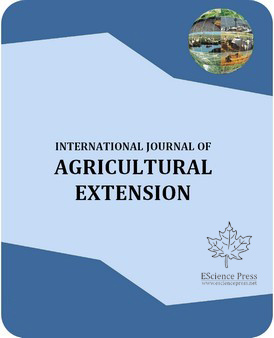International Journal of Agricultural Extension
Vol 12, No 3 (2024): Int. J. Agric. Ext.
Research Articles
Announcements
International Journal of Agricultural Extension has been recognised by Higher Education Commission, Pakistan in "Y category. The edntire team of IJAE is happy for this success. In the meantime, we are indebted to all the authors for their contribution.
If you aspire to be an author, a great place to start is EScience Press.
EScience Press is currently seeking to publish new book ideas and to work with new authors and editors, in areas of potential impact, high topicality and rapid growth across different scientific fields.
| More Announcements... |
International Journal of Agricultural Extension is devoted to publishing authoritative empirical research and conceptual contribution building the theory of agriculture extension especially focusing on community development through practices of agriculture extension education.

International Journal of Agricultural Extension
Editor: Dr. Muhammad Zakaria Yousaf Hassan
Publisher: EScience Press
Format: Print & Online
Print Copy Provider: EScience Press
Frequency: 03
Publication Dates: April, August, December
Language: English
Scope: Agricultural Extension
Author Fees: Yes
Types of Journal: Academic/Scholarly Journal
Access: Open Access
Indexed & Abstracted: Yes
Policy: Double blind peer-reviewed
Review Time: 04-06 Weeks Approximately
Contact & Submission e-mail: ijae@esciencepress.net
Indexed In:




Latest News on Food and Agriculture
A new technology for extending the shelf life of produce | |
| Researchers developed a way to extend the shelf life of vegetables by injecting them with melatonin using biodegradable microneedles. | |
| Posted: 2025-05-21 | More... |
Common diabetes drug helps chickens lay more eggs | |
| What do chickens and people with a common reproductive disorder have in common? More than one might think -- and a widely-used diabetes medication might just be the surprising link. | |
| Posted: 2025-05-20 | More... |
New research reveals Puff adders as an important conservation and rodent control solution | |
| New research has revealed that puff adders (Bitis arietans) can be highly efficient at controlling rodent populations that threaten agricultural production on the continent. | |
| Posted: 2025-05-20 | More... |
Wild spinach offers path to breed disease resistance into cultivated varieties | |
| Several varieties of wild spinach that originated in Central Asia show resistance to a destructive soil-borne pathogen that beleaguers growers of spinach seed in the Pacific Northwest -- a finding that can be used to breed hardier crops. | |
| Posted: 2025-05-20 | More... |
Agrivoltaics enjoys comparatively high acceptance | |
| Photovoltaic systems are increasingly being installed not only on roofs but also on open land. This does not always meet with citizens' approval. What is known as agrivoltaics (Agri-PV), however, is viewed more favorably, as researchers have now been able to show. In this case, the solar cells are installed in spaces used for agriculture -- such as on pastures or as a canopy over grapevines. According to a survey of almost 2,000 people, this form enjoys much higher acceptance than normal solar parks. | |
| Posted: 2025-05-20 | More... |







